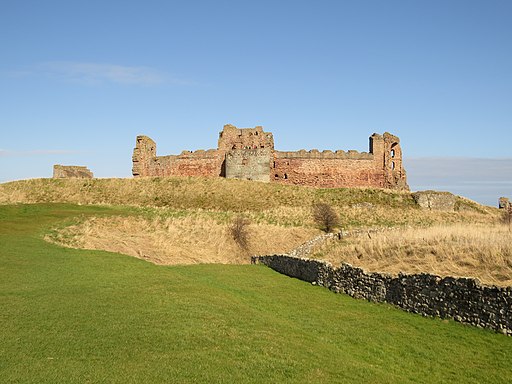Chris Tabraham, formerly Principal Historian for Historic Scotland, entertained us with a talk on the status of women in medieval castles. As a general rule, the wife of a powerful Lord led a somewhat sequestered life managing the household, and was in sole charge during his Lordship’s extended absences. He looked after business in often far-flung and large estates, attended court and travelled with the king around his realm, engaged in other matters of politics and, very likely, in armed conflicts of various sorts. For much of the year the Lord was not in residence. Other women of the establishment had clearly defined roles under the control of her Ladyship, and there were relatively few to deal with: her own personal retinue of maids of the bedchamber and suchlike, probably women of good family. Generally the Lady would work with the castle Steward (male, of course) to oversee the functions of the rest of the establishment – virtually all male. Fundamentally the role of the Lady in the medieval period was to look after her Lord’s domestic needs and to procreate.
Domestic arrangements were quite curious to our modern eye. The Lord and Lady typically had separate bedchambers to which they had access through their own doors. The two rooms often had a linking passageway or door allowing direct access between them. Although the Lady’s bedchamber tended to be the more modest, both were used for socialising and for private meetings with visitors of all sorts. At night, of course, they would be used for sleep and, doubtless, for love.
Although the Lady would be in charge for the long stretches of her husband’s absence, any small children would tend to spent much of their time with nurses and older male children would often be sent elsewhere for their education and knightly training. Hence the domestic duties of the Lady did not seem to involve the children to any great extent.
There were, of course, exceptions to the general invisibility of the Lady. Our own Countess Ada, wife of Prince Henry, heir to the Scottish throne until his death in the mid 12th century, was a powerful woman who was responsible for the creation of Haddington’s Cistercian Convent and who held in her own right, as part of her marriage settlement, large tracts of land in East Lothian and Fife. It is very probable that she and Price Henry lived in a substantial castle, or palace, which once dominated Haddington from the vicinity of the Pleasance. Management of this would also have been her responsibility. With Prince Henry’s early death, and the death of David 1 shortly afterwards, Ada’s sons became successive Kings of Scots. Therefore, as mother to Malcolm IV and William I (the Lion), Countess Ada would have been a powerful and influential presence at court.
Another East Lothian Lady of note was (Black) Agnes, Countess of Moray, wife of Patrick, Earl of Dunbar and March, who saw off the English army besieging Dunbar Castle in 1338. She had been left in charge of the defence of the castle with only a few men at arms while her husband was away fighting in England. Her success, and her mockery of the English are well known. Two incidents in particular come down to us: her maids dusting the battlements after they were struck by rocks from the English catapults, and her loudly advertised ‘gift’ to the English commander of a freshly baked loaf with some good wine to demonstrate how well supplied the Scots were.
In the transition from the medieval period to early modern in the 16th and 17th centuries, things began to change, with the castle or, increasingly, great house, becoming much more of a home for the whole family. However, the division of labour between Lord and Lady remained much the same, and the household remained very much a male dominated hierarchy right through to the 20th century, when war, universal suffrage, death duties and social change saw the demise (well, mostly!) of this privileged sector of society.
Peter R
